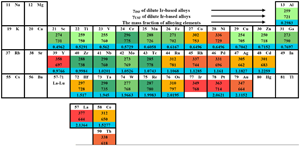Crossref Citations
This article has been cited by the following publications. This list is generated based on data provided by
Crossref.
Chong, Xiaoyu
Shang, Shun-Li
Krajewski, Adam M
Shimanek, John D
Du, Weihang
Wang, Yi
Feng, Jing
Shin, Dongwon
Beese, Allison M
and
Liu, Zi-Kui
2021.
Correlation analysis of materials properties by machine learning: illustrated with stacking fault energy from first-principles calculations in dilute fcc-based alloys.
Journal of Physics: Condensed Matter,
Vol. 33,
Issue. 29,
p.
295702.
Geng, Baoyu
Liu, Zhangxing
Li, Yongkun
Wang, Gui
and
Zhou, Rongfeng
2022.
Analysis of evolution law and mechanism of stacking fault density of M7C3 carbides under the action of the electric current pulse.
Materials Characterization,
Vol. 191,
Issue. ,
p.
112117.
Arora, Gaurav
Manzoor, Anus
and
Aidhy, Dilpuneet S.
2022.
Charge-density based evaluation and prediction of stacking fault energies in Ni alloys from DFT and machine learning.
Journal of Applied Physics,
Vol. 132,
Issue. 22,
Xie, Yuhua
and
Yang, Zehui
2023.
Morphological and Coordination Modulations in Iridium Electrocatalyst for Robust and Stable Acidic OER Catalysis.
The Chemical Record,
Vol. 23,
Issue. 10,
Bai, Xue
Li, Yefei
Wang, Yiran
Zheng, Qiaoling
Fang, Xuewei
Liu, Qingkun
Yan, Bo
and
Gao, Yimin
2023.
A comparative study on the stability of six Ir/Ir3X (X = Ti, V, Zr, Nb, Hf, Ta) interfaces by first-principle and AIMD calculations.
Applied Surface Science,
Vol. 630,
Issue. ,
p.
157502.
Aidhy, Dilpuneet S.
2024.
Chemical randomness, lattice distortion and the wide distributions in the atomic level properties in high entropy alloys.
Computational Materials Science,
Vol. 237,
Issue. ,
p.
112912.
Wang, Yuan
Wang, Tian
Arandiyan, Hamidreza
Song, Guoqiang
Sun, Hongyu
Sabri, Ylias
Zhao, Chuan
Shao, Zongping
and
Kawi, Sibudjing
2024.
Advancing Catalysts by Stacking Fault Defects for Enhanced Hydrogen Production: A Review.
Advanced Materials,
Vol. 36,
Issue. 21,
